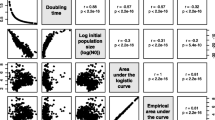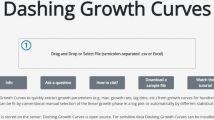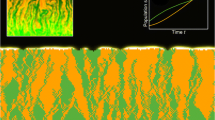Abstract
In this work, we introduce the Growth Curve Analysis Tool (GCAT). GCAT is designed to enable efficient analysis of high-throughput microbial growth curve data collected from cultures grown in microtiter plates. GCAT is accessible through a web browser, making it easy to use and operating system independent. GCAT implements fitting of global sigmoid curve models and local regression (LOESS) model. We assess the relative merits of these approaches using experimental data. Additionally, GCAT implements heuristics to deal with some peculiarities of growth curve data commonly encountered in bioenergy research. GCAT server is publicly available at http://gcat-pub.glbrc.org/. The source code is available at http://code.google.com/p/gcat-hts/.



Similar content being viewed by others
Notes
Users are advised to take care choosing appropriate blank values and OD transform options. For example, in many experiments, OD ranges approximately from 0 to 1. A relatively small δ, e.g., 0.1, can be more appropriate in such cases. Using a large δ affects growth curve shape in a way that parameters such as specific growth rate do not have their customary meanings. The standard log(x) transform is advised if blank OD is known and inoculate OD is sufficiently high.
References
Marques MPC, Cabral JMS, Fernandes P (2009) High throughput in biotechnology: from shake-flasks to fully instrumented microfermentors. Recent Pat Biotechnol 3:124–140
Liti G, Carter DM, Moses AM et al (2009) Population genomics of domestic and wild yeasts. Nature 458:337–341. doi:10.1038/nature07743
Warringer J, Zörgö E, Cubillos FA et al (2011) Trait variation in yeast is defined by population history. PLoS Genet 7:e1002111. doi:10.1371/journal.pgen.1002111
Wood JA, Orr VCA, Luque L et al (2014) High-throughput screening of inhibitory compounds on growth and ethanol production of Saccharomyces cerevisiae. Bioenergy Res 1–8. doi: 10.1007/s12155-014-9535-4
Jin M, Bothfeld W, Austin S et al (2013) Effect of storage conditions on the stability and fermentability of enzymatic lignocellulosic hydrolysate. Bioresour Technol 147:212–220. doi:10.1016/j.biortech.2013.08.018
Jin M, Sarks C, Gunawan C et al (2013) Phenotypic selection of a wild Saccharomyces cerevisiae strain for simultaneous saccharification and co-fermentation of AFEXTM pretreated corn stover. Biotechnol Biofuels 6:108. doi:10.1186/1754-6834-6-108
Parreiras LS, Breuer RJ, Avanasi Narasimhan R et al (2014) Engineering and two-stage evolution of a lignocellulosic hydrolysate-tolerant saccharomyces cerevisiae strain for anaerobic fermentation of xylose from AFEX pretreated corn stover. PLoS One 9:e107499. doi:10.1371/journal.pone.0107499
Sato TK, Liu T, Parreiras LS et al (2014) Harnessing genetic diversity in Saccharomyces cerevisiae for fermentation of xylose in hydrolysates of alkaline hydrogen peroxide-pretreated biomass. Appl Environ Microbiol 80:540–554. doi:10.1128/AEM. 01885-13
Eini A, Sol A, Coppenhagen-Glazer S et al (2013) Oxygen deprivation affects the antimicrobial action of LL-37 as determined by microplate real-time kinetic measurements under anaerobic conditions. Anaerobe 22:20–24. doi:10.1016/j.anaerobe.2013.04.014
Schwarzmüller T, Ma B, Hiller E et al (2014) Systematic phenotyping of a large-scale Candida glabrata deletion collection reveals novel antifungal tolerance genes. PLoS Pathog 10:e1004211. doi:10.1371/journal.ppat.1004211
Kahm M, Hasenbrink G, Lichtenberg-Fraté H et al (2010) Grofit: fitting biological growth curves with R. J Stat Softw 33
Gagneur J, Neudecker A (2012) cellGrowth: fitting cell population growth models
Vaas LAI, Sikorski J, Michael V et al (2012) Visualization and curve-parameter estimation strategies for efficient exploration of phenotype microarray kinetics. PLoS ONE 7:e34846. doi:10.1371/journal.pone.0034846
Vaas LAI, Sikorski J, Hofner B et al (2013) opm: an R package for analysing OmniLog(R) phenotype microarray data. Bioinformatics 29:1823–1824. doi:10.1093/bioinformatics/btt291
Huang L (2013) Eastern regional research center: integrated pathogen modeling program (IPMP 2013). http://www.ars.usda.gov/Services/Docs.htm?docid=23355. Accessed 1 Oct 2014
Huang L (2014) IPMP 2013—a comprehensive data analysis tool for predictive microbiology. Int J Food Microbiol 171:100–107. doi:10.1016/j.ijfoodmicro.2013.11.019
Baranyi J Understanding and predicting the behaviour of bacterial foodborne pathogens. http://www.ifr.ac.uk/safety/DMfit/. Accessed 1 Oct 2014
Baranyi J, Roberts TA (1994) A dynamic approach to predicting bacterial growth in food. Int J Food Microbiol 23:277–294. doi:10.1016/0168-1605(94)90157-0
R Core Team (2014) R: a language and environment for statistical computing. R Foundation for Statistical Computing, Vienna
Bates DM, Watts DG (1988) Nonlinear regression analysis and its applications. Wiley, New York
Bates DM, Chambers JM (1992) Nonlinear models. Stat Models S
port. http://www.netlib.org/port/. Accessed 1 Oct 2014
Cleveland WS, Grosse E, Shyu WM (1992) Local regression models. Stat Models S
Ruby on Rails. http://rubyonrails.org/. Accessed 12 Sep 2013
Hansson DH, Rails core team (2003) Ruby on Rails
Dahl DB, Crawford S (2009) RinRuby: accessing the R interpreter from pure ruby. J Stat Softw 29:1–18
Zwietering MH, Jongenburger I, Rombouts FM, van’t Riet K (1990) Modeling of the bacterial growth curve. Appl Environ Microbiol 56:1875–1881
Birch CPD (1999) A new generalized logistic sigmoid growth equation compared with the Richards growth equation. Ann Bot 83:713–723. doi:10.1006/anbo.1999.0877
Zeide B (1993) Analysis of growth equations. For Sci 39:594–616
Werner-Washburne M, Braun E, Johnston GC, Singer RA (1993) Stationary phase in the yeast Saccharomyces cerevisiae. Microbiol Rev 57:383–401
Shvets V, Zeide B (1996) Investigating parameters of growth equations. Can J For Res 26:1980–1990. doi:10.1139/x26-224
Hastie T, Tibshirani R, Friedman J (2011) The elements of statistical learning: data mining, inference, and prediction, Second Edition, 2nd ed. 2009. Corr. 7th printing 2013 edition. Springer, New York, NY
Acknowledgments
We gratefully acknowledge Drs. David Benton, Richard LeDuc, Peris Navarro, and Steven Slater for encouragement and stimulating discussions. James McCurdy and Michael H. Whitney contributed to GCAT software development. Branden Timm was instrumental in the deployment of GCAT software and gave valuable advice on security. This work was funded by the DOE Great Lakes Bioenergy Research Center (DOE BER Office of Science DE-FC02-07ER64494).
Conflict of Interest
The authors declare that they have no conflict of interest.
Author information
Authors and Affiliations
Corresponding author
Electronic supplementary material
Below is the link to the electronic supplementary material.
ESM 1
(XLSX 270 kb)
ESM 2
(PDF 5 kb)
ESM 3
(PDF 1332 kb)
ESM 4
(PDF 5 kb)
ESM 5
(PDF 5 kb)
ESM 6
(PDF 5 kb)
ESM 7
(XLSX 36 kb)
ESM 8
(XLSX 27 kb)
ESM 9
(XLSX 26 kb)
ESM 10
(XLSX 27 kb)
ESM 11
(XLSX 27 kb)
ESM 12
(XLSX 98 kb)
ESM 13
(XLSX 11 kb)
ESM 14
(PDF 5 kb)
ESM 15
(XLSX 30 kb)
ESM 16
(XLSX 24 kb)
ESM 17
(XLSX 137 kb)
ESM 18
(PDF 5 kb)
ESM 19
(XLSX 31 kb)
ESM 20
(XLSX 26 kb)
Rights and permissions
About this article
Cite this article
Bukhman, Y.V., DiPiazza, N.W., Piotrowski, J. et al. Modeling Microbial Growth Curves with GCAT. Bioenerg. Res. 8, 1022–1030 (2015). https://doi.org/10.1007/s12155-015-9584-3
Published:
Issue Date:
DOI: https://doi.org/10.1007/s12155-015-9584-3




